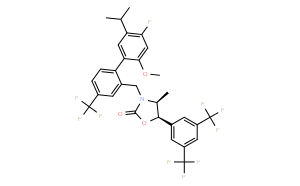| Description |
Anacetrapib (MK0859) is a potent, selective, reversible rhCETP and mutant CETP(C13S) inhibitor with IC50 of 7.9 nM and 11.8 nM, increases HDL-C and decreases LDL-C, does not increase aldosterone or blood pressure. Phase 3. |
|
Targets
|
| rhCETP [1] |
Mutant CETP (C13S) [1] |
| 7.9 nM |
11.8 nM |
|
| In vitro |
Anacetrapib is not only able to increase HDL-cholesterol, but also further decreases LDL-cholesterol when taken in combination with a statin. Anacetrapib dose-dependently and significantly decreases the transfer of CE from HDL3 to HDL2. Anacetrapib doesn't affect the amount of [14C]-dalcetrapibthiol bound to rhCETP. Anacetrapib decreases pre-β-HDL formation by more than 46%. [1] Anacetrapib potently blocks CE and TG transfer in 95% human serum.[2]
|
| In vivo |
In a dyslipidemic hamster model, 60 mg/kg/day Anacetrapib for 2 weeks results in a 94% reduction in CETP activity and 47% increase in HDL-cholesterol compared with control animals; non-HDL-cholesterol concentrations are not affected. In addition, Anacetrapib promotes reverse cholesterol transport from macrophages, and leads to a 30% increase in fecal cholesterol content. HDL from Anacetrapib-treated hamsters reveals an increase in SR-B1- and ABCG1-mediated efflux compared with controls. [2] After oral administration of [14C]Anacetrapib at 10 mg/kg, ∼80 and 90% of the radioactive dose is recovered over 48 hous postdose from rats and monkeys, respectively. The majority of the administered radioactive dose is excreted unchanged in feces in both species. [3]
|

 COA
COA MSDS
MSDS HPLC
HPLC NMR
NMR